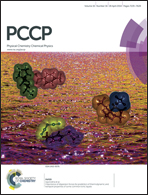Highly effective catalysis of the double-icosahedral Ru19 cluster for dinitrogen dissociation – a first-principles investigation†
Abstract
The N2 bond cleavage is the rate-limiting step in the synthesis of ammonia, and ruthenium is a catalyst well known for this reaction. The double-icosahedral (D5h) Ru19 cluster is famous as an active catalyst, and has a remarkable stability towards the adsorption of H2, N2 and CO. Using first-principles calculations, we have investigated the adsorption and dissociation of dinitrogen on a double-icosahedral Ru19 cluster. Our results show that the hollow site in the rhombus region (BHB site) of the Ru19 cluster possesses the greatest catalytic activity to dissociate N2, with the reaction barrier of 0.89 eV and an exothermicity of −1.45 eV. Multiple coadsorption of N2 on the cluster (i.e. coadsorption of 2N2 and 3N2 on a single Ru19 cluster) causes the barrier to dissociate N2 to be less on a BHB site than for adsorption of a single N2. To understand the catalytic properties of a Ru19 cluster towards N2 bond cleavage, we calculated the electron population, vibrational wavenumbers and local densities of states; the results are explicable.


 Please wait while we load your content...
Please wait while we load your content...